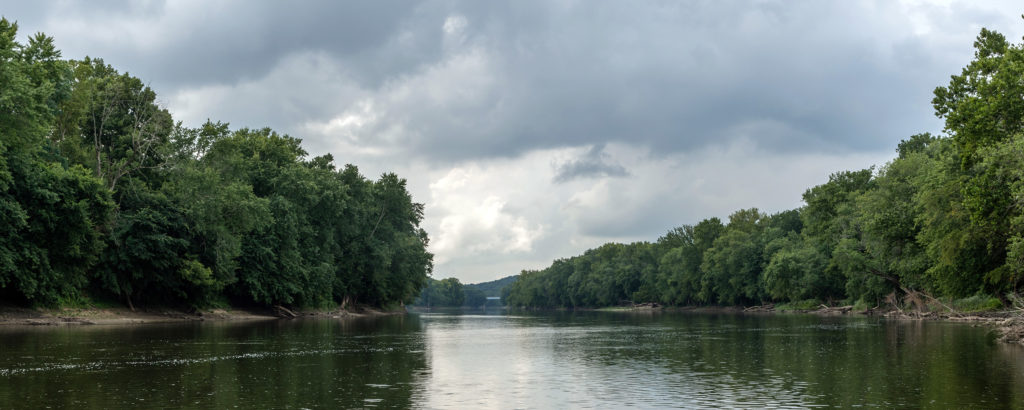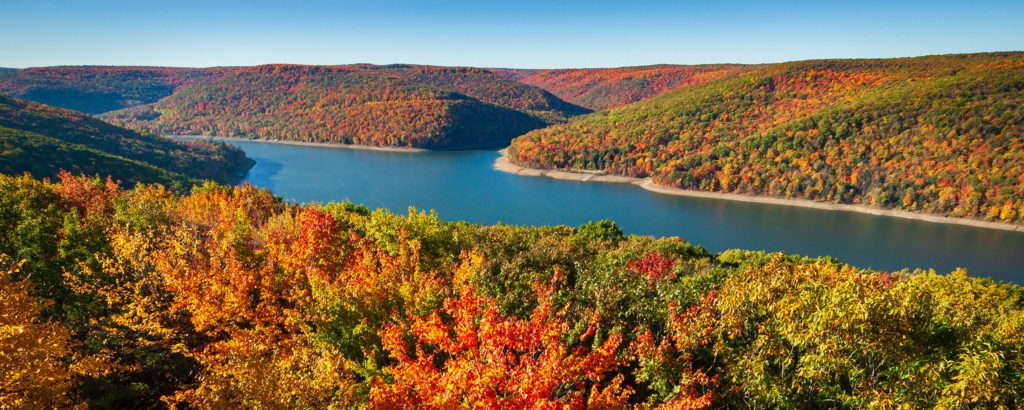A three-year EPRI research initiative provides tools for energy companies to understand and adapt to water resource challenges
In some respects, the Wabash and San Juan rivers are quite similar. From its headwaters in the west of Ohio, the Wabash flows about 765 kilometers through Indiana and along the border with Illinois until it joins up with the Ohio River near where Illinois, Kentucky, and Indiana meet. The San Juan River runs 616 kilometers from southern Colorado through northwestern New Mexico and southeastern Utah before reaching the Colorado River. But the similarities of the Wabash and San Juan rivers more or less end with their length and the fact that both traverse multiple states.
The Wabash River Basin is largely flat, made up of farms growing corn and soybeans. Precipitation is plentiful. In fact, since 1895, Indiana—where most of the river basin is located—has seen its average annual snow and rainfall increase by about 15 percent. By contrast, the 38,000-square-mile San Juan River Basin is a study in extremes, combining tall mountains and flat valleys. Though the basin is extremely dry overall, its mountainous northeastern regions receive up to 60 inches of precipitation each year, while the southern and central portions get an average of only 10 inches; some of the hotter and drier areas experience years of no precipitation at all.
A Changing Climate and an Ongoing Reliance on Water
The Wabash and San Juan river basins have something else in common; however, temperatures and precipitation patterns are changing due to climate change. In the Wabash basin, changes are likely to include a general increase in annual precipitation, albeit with more extremely wet and unusually dry years. Flooding could be more of a challenge at times, as could water quality issues due to higher water temperatures. The San Juan River Basin is increasingly subject to extreme drought conditions that drastically reduce the availability and flow of water throughout the region.
Climate change is impacting river basins and water resources throughout the United States and around the globe. Understanding and planning for these changes is particularly important for the electric power industry. Indeed, there is a tight nexus between water availability and the operation of electric energy companies. For example, reliable access to water is critical to cool many fossil fuel and nuclear power plants. Hydropower plants directly rely on water to generate electricity. And many regulatory compliance issues are connected to how utility operations impact water quality.
Rising global temperatures and increasingly frequent extreme weather events associated with climate change are already altering how energy companies need to plan and operate. For instance, companies that depend on hydropower to supply electricity to customers must adjust their strategies for meeting demand in the face of decades-long droughts. Already, Hoover Dam’s energy capacity has been reduced 25 percent as a result of record low (and still dropping) water levels at Lake Mead, which, like the San Juan, is part of the Colorado River Basin. Other water-related challenges energy companies face include ensuring some power plants are designed to withstand storm surges and floods and avoiding damage to dams and levees during extreme weather events.
Equipping energy companies with tools and a framework to understand and plan for climate-related changes to water resources has been the focus of three years of wide-ranging research recently completed by EPRI. “When we started this work, a big driver of it was that there was no way to look at how climate-based projections interfaced with hydrologic models and how to make decisions,” said Nalini Rao, principal technical leader at EPRI. “Companies want to know the risks and also what to do about it.”
To provide the framework and guidance energy companies need, EPRI focused its research on three areas. One was evaluating the climate and water data and models available to grasp possible changes to water resources. Another was how energy companies could take what they learned from models and data to understand better the risks they faced. The third was adaptation strategies energy companies could implement to effectively manage climate-related changes to water resources.
As part of the research initiative, EPRI also conducted pilot studies identifying and quantifying water-related risks to the power industry in the Wabash, San Juan, and Allegheny river basins. The three river basins were intentionally selected for their varying geographic locations, topographies, and precipitation patterns.

Evaluating Models
A foundational step in the research was examining the many models energy companies could use to assess how climate change may impact water quality and availability. In 2020 EPRI released the resulting report, Evaluation of Hydrological Models for Climate-Based Assessments. In total, EPRI evaluated 22 models using a range of factors, including the models’ complexity and their ability to model extreme events and to produce outputs relevant to the power sector, such as estimated stream flow and flooding. Another criterion was how easy or difficult it would be to apply models to specific geographic regions—an important factor, given that energy companies have defined geographic service territories.
The next step was to apply similar water resource and climate models to real-world conditions in the Wabash, Allegheny, and San Juan river basins. The two models selected for the analysis were the Watershed Assessment Risk Management Framework (WARMF) model and the Soil-Water Assessment Tool (SWAT). WARMF and SWAT were chosen because they are able to model both hydrology and water quality, are free and widely available, and can model many of the potential implications of climate change, such as flooding, drought, and low water flow conditions.
These two water resource models also incorporate projections of future climate conditions through the end of this century provided by general circulation models (GCMs). The GCMs selected for the pilot projects were chosen for their accuracy in reproducing past water conditions and their ability to produce future projections based on two future climate scenarios: one with a modest amount of regulation of greenhouse gas emissions and another with no regulation or reduction of emissions. Other selection criteria were how easily researchers could apply model results to local conditions – a process known as downscaling—and whether these downscaled data products were already available.
The selected tools were applied to the three river basins to quantify the potential water risks of a changing climate. For example, in the Wabash River Basin, researchers looked at the potential for more frequent floods and impacts on freshwater mussel habitat due to more severe and frequent drought conditions. In the Allegheny River Basin, the models were applied to understand better how a changing climate could affect thermal generation facilities due to the increasing temperatures of source water used for cooling. The research results are included in the EPRI report, Quantifying Potential Impacts of Water-Related Risks Associated with Climate Change.

Quantifying Water-related Risks in the Southwestern United States
In the San Juan River Basin, the study looked at what extended, and extreme drought conditions could do to hydropower production. In particular, researchers examined what drought conditions could mean for the Navajo Dam Hydroelectric Plant in Farmington, New Mexico. The 30-megawatt Navajo Dam is one of four power plants providing electricity to the 45,000 commercial and residential customers of the Farmington Electric Utility System. The analysis utilized three versions of the SWAT model and incorporated GCM simulations of both modest emissions regulation and none.
The results illustrate several potential water-related challenges faced by the owners of the Navajo Dam and other energy companies across the Southwest that rely on hydroelectric power. For example, the increased frequency and severity of drought in the region could lead to a reduction in stream flows and higher levels of water evaporation. Though there are differences in the scenarios produced by the different models, the impacts of ongoing drought could be lost revenue from electricity sales, increased utility costs to make up for generation not provided by hydropower, and higher customer rates.
Other conclusions from the analysis include the likelihood that the Southwest will continue to face hard choices about the use of water held in large reservoirs. For example, limited water supplies may require some crops requiring irrigation to lie fallow. Further, wind and solar development could increase across the region to make up for reductions in hydropower production because both generation sources are generally cheaper than coal, natural gas, and hydropower facilities.

Effective Adaptation Strategies
The third important aspect of EPRI’s research focused on steps energy companies can take to minimize some of the water risks posed by a changing climate. “Companies obviously want to know what risks they face, and the modeling helps provide that,” said Jeff Thomas, an EPRI principal technical leader. “But they also need to know what to do about it and how much different approaches cost.”
Several potential interventions are identified in the EPRI report, Program on Technology Innovation: Minimizing Risks to the Electric Power Industry from Changing Water Conditions. The approaches aim to mitigate risk through actions that reduce the impact of floods, restore natural water flow, improve water quality, and lessen stream erosion. Strategies evaluated included the construction of bankfull wetlands, which involves removing several feet of sediment from a floodplain. This frees up space that could be used to store water during times of flooding, which can create a wetland habitat.
Another strategy examined was the reintroduction of beavers to a watershed. The activity of beavers can profoundly impact the flow of water, including reducing erosion, improving water quality, and helping landscapes maintain moisture during drought. The study also looked at the potential impact of careful placement of log structures in small streams as a way to reduce erosion and create a more natural flow of water.
Researchers examined the effects different interventions could have in the San Juan, Wabash, and Allegheny river basins. The potential benefits identified are both significant and cost-effective. Overall, these measures would expand the amount of water storage available in each river basin. Expanded storage results in less erosion, decreased flood damage, higher water quality, reduced drought conditions, and other benefits.
In the Wabash River Basin, for example, the combined impact of constructing bankfull wetlands, reintroducing beavers, and placing logs could add 9.2 billion cubic meters of storage, which is nearly six times the existing storage volume. The same measures applied in the Allegheny and San Juan river basins have the potential to increase storage by 20 percent and 3 percent, respectively.
Taken together, the work to identify appropriate models, evaluate climate risks, and evaluate mitigation strategies is meant to provide energy companies with a framework to approach their own unique water resource challenges. “This study was not intended as an assessment for individual companies or to answer specific questions, although we are hoping to do work in the future that does just that,” Thomas said. “We wanted to create a framework energy companies could use to do their own assessments, identify their own risks, and understand their options for mitigation and adaptation. There are so many decisions about which models to choose, how to downscale them for a region, and what metrics matter. Building a framework provides a pathway to navigate this world of options.”
EPRI Technical Experts:
Nalini Rao and Jeff Thomas
For more information, contact techexpert@eprijournal.com.

